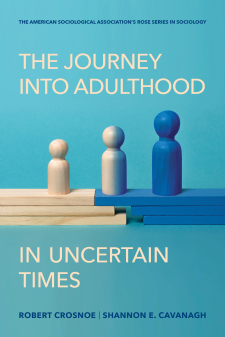Main navigation
This feature is part of an ongoing RSF blog series, Work in Progress, which highlights some of the ongoing research of our current class of Visiting Scholars.
We tend to think of race as a part of one’s identity that stays fixed throughout their lifetime—unlike socioeconomic status, which has the potential to change. But new research by current Visiting Scholar Aliya Saperstein (Stanford) offers a provocative new perspective on the mutability of race today.
During her time in residence at the Russell Sage Foundation, Saperstein is completing a book that examines the ways in which an individual’s racial status can shift based on changes to their social status. Her research focuses on the fluidity of racial perceptions, including how people self-identify racially, how they are classified by others, and how conceptions of race change both within and across generations.
In a new interview, Saperstein discussed how using a “racial mobility perspective” can help social scientists conceptualize the complex interactions between race and socioeconomic status today.
Q. What is a racial mobility perspective? How does it build upon what social scientists already understand about status attainment and socioeconomic mobility to highlight important features of racial inequality in the US?
The existence of social mobility is a key tenet of a meritocratic society: we expect that people who start on the bottom should be able to work their way up through hard work and intelligence. To determine whether or not this expectation translates into reality, social scientists have long monitored how people’s social origins—including their sex, country of birth, and class background—either facilitate or constrain their opportunities and outcomes. Race has also been considered a crucial factor in the U.S. because studies find much more socioeconomic mobility among some racial populations than others.
Until recently, race has been treated only as an input into this process: an ascribed characteristic that can be assigned to people at birth and shapes later interactions with teachers, hiring managers, landlords, police officers, etc. But social mobility and people’s life outcomes also have consequences for how they self-identify and are perceived racially. Perhaps because Americans have such strong stereotypes about what “black” and “white” people do and don’t do, moving up and down the socioeconomic ladder is often accompanied by what I call “racial mobility.” People are more likely to be seen as white when their social status increases, and less likely to be seen as white when it decreases, for example through losing their job, falling into poverty or being incarcerated. The opposite also occurs; people are more likely to be seen as black when they suffer setbacks and less likely to be seen as black when things are going well in their lives. Recognizing that a person’s race can change, and that racial fluidity in the United States is not purely random but follows particular patterns, helps us better understand how ideas about race and racial difference maintain inequality.
Q. In what ways is race both an ascribed and an achieved characteristic? How does data from the Census and other sources help clarify this?
An ascribed characteristic is something a person is born with and/or a category that is imposed by others. This is how race has typically been defined. Achieved characteristics are those that people learn, seek out, or otherwise acquire over the course their lives, such as their education, occupation or marital status. The key distinctions between the two are that ascribed characteristics are considered fixed and out of a person’s control, while achieved characteristics are changeable. People can switch careers, get married—and divorced—or acquire new skills and a more advanced degree.
By following the same people from one decade to the next in the U.S. census, or from one year to the next in national surveys, we can see when and how their lives change along these dimensions. We also see that not only how people are racially classified by others but also how they racially identify themselves can change—often along with other achieved characteristics. In that sense, we can think of race as being both achieved and ascribed. We all have racial origins that are a part of our family background. My research shows we also have racial destinations that are consequences of our life experiences. The racial origins and destinations of most Americans will be the same, just like many people stay in the same social class as their parents. Nevertheless, acknowledging that an individual’s race cannot be taken for granted has important implications for both research practices and policy.
Q. How can understanding racial mobility help us better craft policies to alleviate inequality in the US today?
A racial mobility perspective may not generate brand new policy solutions as much as it brings renewed urgency to old concerns about balancing opportunity for individuals with efforts to promote the group or common good. My research suggests that it has been all too easy to redefine individuals to “fit” their new life circumstances rather than revise our shared racial stereotypes about “whites” or “blacks” or “Asians.” So even as some individuals experience mobility and success, the overall system remains stacked against those who cannot escape the combination of their racial and social origins. Indeed, the cycle becomes a particularly vicious one when we not only reclassify nonwhites who succeed as white but also we reclassify whites who do not succeed as nonwhite. This further cements widespread associations of positive outcomes with “white” people and negative outcomes with nearly everyone else.
It is this added barrier of the racial self-fulfilling prophecy that must be overcome. We cannot expect to break down more than a century of stereotypical expectations with policies that open doors for Americans from disadvantaged racial and social origins one by one. By doing so the upwardly mobile are cast as exceptions that leave our fundamental beliefs about “whites” or “blacks” intact. Broad-based social service provision put a dent in shared stereotypes in a similar situation in the past, when federal programs from the GI Bill to home mortgage assistance helped to propel millions of previously racially suspect European immigrants into middle-class white respectability. However, entrenched racism kept African Americans from reaping the benefits of most of those initiatives, ensuring that over the course of the 20th century “blackness” became synonymous with poverty, joblessness, incarceration, and the inner-city. Those fateful implementation decisions at the state and local levels helped to harden racial inequality in this country and continue to color how Americans see and think about one another. Perhaps new efforts—like the President’s proposal to provide free access to community college—will eventually succeed where previous federal programs failed, if we follow through and make sure the benefits are available to everyone.





